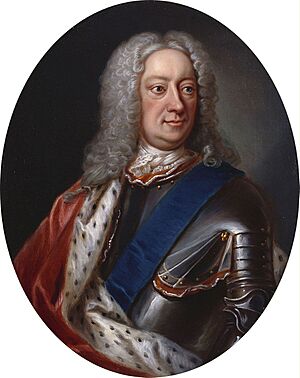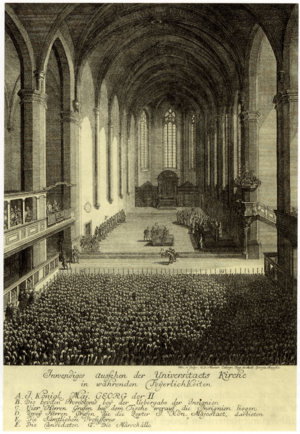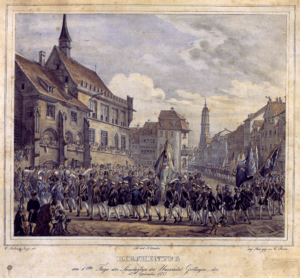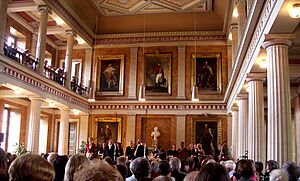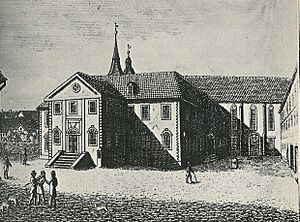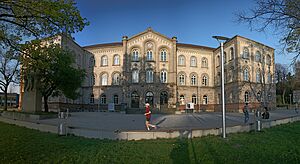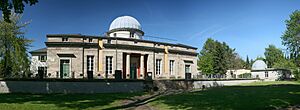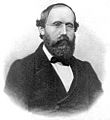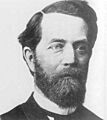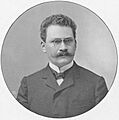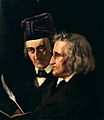University of Göttingen facts for kids
|
Georg-August-Universität Göttingen
|
|
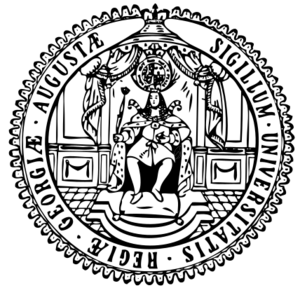 |
|
| Latin: Universitas Regiæ Georgiæ Augustæ | |
| Motto | In publica commoda (Latin) |
|---|---|
|
Motto in English
|
For the good of all |
| Type | Public |
| Established | 1734 |
| Budget | €1.438 billion |
| President | Axel Schölmerich |
|
Academic staff
|
4,551 (2021) |
|
Administrative staff
|
8,825 (2021) |
| Students | 30,200 (2020–2021) |
| 713 (2021) | |
| Location |
Göttingen, Lower Saxony
,
Germany
|
| Campus | University town |
| Colours | Dark blue |
| Affiliations | German Excellence Universities, U15, EUA, U4 Network, Guild of European Research-Intensive Universities |
 |
|
The University of Göttingen, also known as the Georg August University of Göttingen (German: Georg-August-Universität Göttingen), is a public research university in Göttingen, Germany. It was founded in 1734 by George II of Great Britain, who was also the King of Great Britain and the Elector of Hanover. The university started teaching in 1737 and is the oldest university in Lower Saxony.
This university is famous for its long history and traditions. It has been connected to 47 Nobel Prize winners. The University of Göttingen is part of the U15 Group, which includes Germany's top research universities. It also works with important international groups like The Guild. The university partners with leading research places in Göttingen, such as the Max Planck Society. The Göttingen State and University Library is one of Germany's largest libraries, with many books and old manuscripts.
Contents
A Look at the University's History
How the University Began
In 1734, King George II of Great Britain wanted a university built in Göttingen. He asked his Prime Minister, Gerlach Adolph von Münchhausen, to make it happen. The goal was to spread new ideas from the Enlightenment. Even Napoleon once said that Göttingen was "the University of Europe."
At first, the university was quite small. It only had a riding hall and a fencing house. Classes were held in the Paulinerkirche, an old monastery, or in professors' homes. A proper university building for lectures was not built until the 1800s.
The 1700s and 1800s
During the 1700s, the University of Göttingen was known for its freedom of thought and scientific discovery. Georg Christoph Lichtenberg was a famous professor who taught experimental physics from 1769 to 1799. By 1812, Göttingen had a library with over 200,000 books. It became a modern and well-known university, encouraging new scientific ideas.
In its early years, the university was especially famous for its Law Faculty. Many important people studied law here. These included Klemens Wenzel Lothar von Metternich, who became a Prime Minister in Austria, and Wilhelm von Humboldt, who later started the University of Berlin. In the 1800s, scholars like Gustav Hugo helped create new ways of thinking about law.
Göttingen was a very popular place to study law in Germany. The famous German poet Heinrich Heine earned his law degree here in 1825. Otto von Bismarck, who later became the first Chancellor of the German Empire, also studied law in Göttingen in 1833. He lived in a small house outside the city walls, supposedly because he was a bit rowdy! By 1837, the university was known as the "university of law" because so many students studied it.
The Theology Faculty also became a global center for studying religion and ancient history.
In 1809, Arthur Schopenhauer, a famous German philosopher, studied at the university. He learned about metaphysics and psychology.
The university was also important for studying history. It developed the Göttingen school of history. Later, Max Weber, a very important thinker about modern society, also studied history in Göttingen.
The Brothers Grimm, famous for fairy tales like "Cinderella" and "Snow White", taught here. They also started compiling the first German dictionary.
However, there were some political problems. In 1837, seven professors, known as the Göttinger Sieben, were expelled. They protested against a change to the constitution by King Ernest Augustus, King of Hanover. This event affected the university's reputation for a while.
The Early 1900s: A Time of Great Science
Around the late 1800s and early 1900s, the University of Göttingen reached its highest point in academics. It became especially strong in natural sciences, particularly mathematics. This started with Carl Friedrich Gauss, known as "the Prince of Mathematicians," who taught here. Later, David Hilbert and Felix Klein attracted mathematicians from all over the world, making Göttingen a top center for mathematics.
By 1903, the university had 121 teachers and 1529 students. Edmund Husserl, a famous philosopher, came to teach here. Ludwig Prandtl joined in 1904 and made the university a leader in fluid mechanics and aerodynamics. He helped understand how air flows around objects. Many of his students made important discoveries in aerodynamics.
Between 1921 and 1933, the physics department was led by Max Born. He was one of the scientists who helped create quantum mechanics, which explains how tiny particles behave. J. Robert Oppenheimer, known as the "father of the atomic bomb," was one of Max Born's students and earned his doctorate here.
During this time, German became an important language for academics worldwide. Many students from other countries, especially the US, came to study in Germany. The University of Göttingen had a big impact on the United States. Many American politicians, lawyers, and writers studied here, including Edward Everett, who became a US Secretary of State and President of Harvard University.
Changes in the 1930s
In the 1930s, the university faced a difficult time. The Nazi government removed many talented academics, especially those who were Jewish. This was called the "great purge" of 1933. Scientists like Max Born, James Franck, and Emmy Noether were forced to leave or fled Germany. Most of them went to places like the United States and the United Kingdom.
After this, in 1934, David Hilbert, a symbol of German mathematics, was asked how mathematics was doing in Göttingen. He sadly replied, "There is no mathematics in Göttingen anymore."
Rebuilding After the War
After World War II, the University of Göttingen was the first university in the western parts of Germany to reopen in 1945. Its connection to famous people continued. Jürgen Habermas, a well-known German philosopher, studied here. Later, Richard von Weizsäcker, who became a President of Germany, earned his law degree here. Gerhard Schröder, a former Chancellor of Germany, also graduated from the Law Faculty. Ursula von der Leyen, who is now the President of the European Commission, studied economics in Göttingen.
University Campus
The university buildings are spread out in different parts of the city.
The main university area, with the Central Library and student dining hall (Mensa), is near the city center. This area includes faculties for Theology, Social Sciences, Law, Economics, and Languages. Other departments like Ancient History and Psychology are also nearby. South of the city, you'll find the Faculty of Mathematics and Computer Science. The Medical Faculty and its hospitals are in other parts of the city.
North of the city, a new science center has been built. Most natural sciences, like chemistry, biology, and physics, are now located there.
The University Library
The Göttingen State and University Library (SUB Göttingen) is very important to the university. It has about 9 million items, including valuable old manuscripts. It serves the university, the German State of Lower Saxony, and the Göttingen Academy of Sciences.
University Gardens
The university has three botanical gardens. These are the Alter Botanischer Garten, the Neuer Botanischer Garten, and the Forstbotanischer Garten. They are used for studying plants and nature.
How the University is Organized
As of 2023, the university has 13 faculties and about 22,484 students. There are 535 professors and over 4,000 academic staff. More than 7,000 technical and administrative staff also work there. After World War II, the university grew and built a new, modern area in the north of the city. You can still see the old university buildings like the Auditorium Maximum and the Great Hall in the city center.
University Departments and Study Areas
The University of Göttingen has 13 main faculties (departments) and many other centers and institutes.
- Faculties
- Agricultural Sciences
- Biology and Psychology
- Chemistry
- Forest Sciences and Forest Ecology
- Geoscience and Geography
- Mathematics and Computer Science
- Physics
- Law
- Social Sciences
- Economic Sciences
- Humanities
- Theology
- Medical Center (Universitätsmedizin Göttingen)
University Rankings
| University rankings | ||||||||||
|---|---|---|---|---|---|---|---|---|---|---|
| Overall – Global & National | ||||||||||
|
||||||||||
The University of Göttingen is highly ranked among universities worldwide. In the QS World University Rankings for 2024, it was ranked 232nd globally and 13th in Germany. The Times Higher Education World University Rankings for 2024 placed it 111th globally and 10th in Germany. According to the 2023 ARWU World Rankings, it was in the top 151–200 universities globally and among the top 6–9 in Germany. In the 2024–2025 US News Best Global Universities Rankings, it was ranked 172nd worldwide and 8th in Germany.
The university has received special funding for its research in areas like "Neurosciences and Molecular Biosciences" and "Microscopy at the Nanometer Range." This shows its strength in scientific research.
Famous History and Impact
The University of Göttingen has a very important place in history. A study in 2017 looked at how influential universities have been over the past ten centuries. The University of Göttingen ranked 20th in terms of "web page rank" (how often it's searched online) and 6th overall when combining different data.
As of 2002, the University of Göttingen was linked to 44 Nobel Prize winners. This number alone puts it among the top 15 universities in the world. Recent Nobel winners connected to the university include Klaus Hasselmann (Physics, 2021), Stefan Hell (Chemistry, 2014), Thomas C. Südhof (Medicine, 2013), and Thomas Arthur Steitz (Chemistry, 2009). Many of them studied or worked at the university or related research institutes in Göttingen.
Today, many judges in top national and international courts are connected to the Law Faculty. For example, in 2021, four out of sixteen judges in Germany's highest constitutional court had ties to the University of Göttingen. Also in 2021, Georg Nolte, a former professor from Göttingen, became a judge at the International Court of Justice.
Partner Institutions
The university works closely with several other important research institutions in the Göttingen Campus. These include:
- Bernstein Network Computational Neuroscience
- European Neuroscience Institute Göttingen (ENI-G)
- German Aerospace Center
- German Center for Neurodegenerative Diseases
- German Primate Center
- Max Planck Institute for Dynamics and Self-Organization
- Max Planck Institute for Multidisciplinary Sciences
- Max Planck Institute for Solar System Research
- Max Planck Institute for the Study of Religious and Ethnic Diversity
Exchange Programs
Since Germany is part of the European Union, students can join the Erasmus Programme to study in other European countries. The university also has exchange programs with well-known universities outside Europe. These include Tsinghua University and Peking University in China, Kyoto University in Japan, and Amherst College in the United States.
University Traditions
The most famous tradition at the university involves PhD students. After they pass their final oral exam, they ride in a wagon decorated with flowers and balloons. They drive to the Marktplatz, the main square, where the old town hall and the Gänseliesel statue are. The new doctor then climbs up to the Gänseliesel statue, kisses her, and gives her flowers.
Student Life
There's an old saying about life in Göttingen, written in Latin on the wall of the Ratskeller (a restaurant in the old town hall): Latin: Extra Gottingam non est vita, si est vita, non est ita. This means, "There is no life outside Göttingen. Even if it is life, it is no life like here."
"Ancient university towns are wonderfully alike. Göttingen is like Cambridge in England or Yale in America: very provincial, not on the way to anywhere – no one comes to these backwaters except for the company of professors. And the professors are sure that this is the centre of the world. There is an inscription in the Ratskeller there which reads 'Extra Gottingam non est vita', 'Outside Göttingen there is no life'. This epigram, or should I call it epitaph, is not taken as seriously by the undergraduates as by the professors."
The university offers several snack shops and six student dining halls (Mensas) where students can get affordable lunch. One Mensa also serves dinner.
Famous People from Göttingen University
Many famous people have studied or taught at the University of Göttingen. These include the American banker J. P. Morgan, the seismologist Beno Gutenberg, and the doctor Hakaru Hashimoto. Several Nobel laureates like Max Planck and Werner Heisenberg also have connections to the university. The German inventor of the jet engine, Pabst von Ohain, studied aerodynamics here.
Images for kids
-
Bernhard Riemann, Mathematician
-
Felix Klein, Mathematician
-
David Hilbert, Mathematician
-
Hermann Minkowski, Mathematician, one of Albert Einstein's teachers
-
Max Born, Physicist, 1954 Nobel Prize in Physics
-
Werner Heisenberg, Physicist, 1932 Nobel Prize in Physics
-
Robert Oppenheimer, Physicist, "Father of the atomic bomb"
-
Niels Bohr, Physicist, 1922 Nobel Prize in Physics
-
Max Planck, Physicist, 1918 Nobel Prize in Physics
-
Stefan Hell, Physicist, 2014 Nobel Prize in Chemistry
-
Erwin Neher, Biophysicist, 1991 Nobel Prize in Physiology or Medicine
-
Carol W. Greider, Biochemist, 2009 Nobel Prize in Physiology or Medicine
-
Thomas Südhof, Molecular biologist, 2013 Nobel Prize in Physiology or Medicine
-
Arthur Schopenhauer, Philosopher
-
Max Weber, Sociologist, historian, jurist, and political economist
-
Jürgen Habermas, Philosopher and social theorist
-
Brothers Grimm, writers and storytellers of folktales
-
Heinrich Heine, Poet, writer and literary critic
-
Wilhelm von Humboldt, Founder of the Humboldt University of Berlin
-
Rudolf von Jhering, Jurist
-
Otto von Bismarck, "Iron Chancellor" of the German Empire
-
Richard von Weizsäcker, Former President of Germany
-
Gerhard Schröder, Former Chancellor of Germany
-
Ursula von der Leyen, President of the European Commission
See also
 In Spanish: Universidad de Gotinga para niños
In Spanish: Universidad de Gotinga para niños


